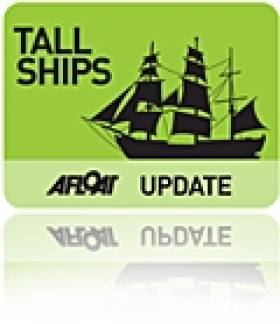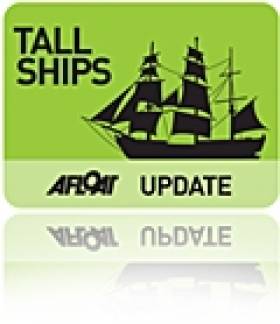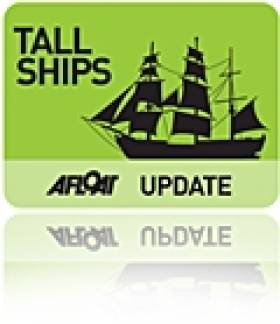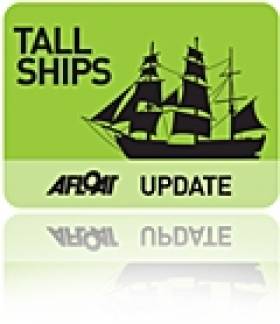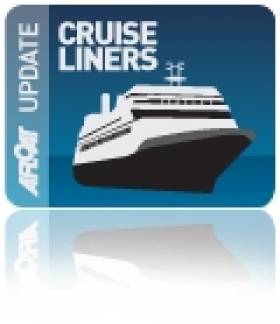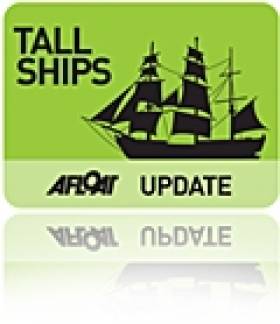Displaying items by tag: Tall Ships
Speculation over Loss of HMS Bounty 'Not Helpful' – Tall Ships America
#Tallships – The education under sail organisation in the United States, 'Tall Ships America' has expressed its hope for the speed recovery of HMS Bounty Captain following the foundering of HMS BOUNTY during Hurricance Sandy this week. The organisation has also said the current speculation into the sinking of the vessel is not helpful at this time.
Tall Ships America have issued the following statement: The tall ship HMS BOUNTY was lost yesterday in Hurricane Sandy off Cape Hatteras, North Carolina. Of the 16 persons reportedly aboard at the time, we understand that one individual has perished, and that 14 others were rescued, thanks to the exemplary courage and skill of Coast Guard search and rescue personnel. It appears that the vessel's master, Robin Walbridge, is missing, and the search continues.
A member of Tall Ships America, HMS BOUNTY was a popular participant in public maritime festivals around North America. Our membership is united in sending our thoughts, prayers and best wishes to the crew and their families, to the family of the crewmember who was lost, and to the brave Coast Guard team who sustain our hopes for Captain Walbridge's speedy rescue.
There is currently much speculation about the loss of the vessel. We believe that further speculation is not helpful at this time, especially in view of the respect that is due to the individuals whose lives are directly affected by these tragic events. Tall Ships America does not have any factual information to add but notes that there will surely be an official inquiry that will assemble much more complete information than is available to anyone now. We are confident that our membership, if called upon, will cooperate with that inquiry in the full spirit of professionalism upon which the sail training movement depends.
For now, we appeal to the public to lend their thoughts and support to the crew and shore team of HMS BOUNTY and their families, to join us in thanking the Coast Guard rescue team for their heroism on behalf of our colleagues, and to sustain hopes for Captain Walbridge's safe return.
Tall Ships America is a non-profit organization dedicated to enriching youth education through character building and leadership programs aboard tall ships. It is the hub for tall ship activity, expertise, and information in North America, and is commended by Congress as the Sail Training organization representing the United States.
#tallship – A Tall Ship replica 18th-century sailing vessel, a visitor to Irish ports in 2009, was caught in Hurricane Sandy's and sunk leaving the captain missing and forcing the crew into liferafts in rough seas off the North American coast.
The U.S. Coast Guard rescued 14 people by helicopter and spent much of the day searching for two missing crew members.
One of them, 42-year-old Claudene Christian, was found unresponsive in the water on Monday evening. She was taken to hospital while rescuers continued to search for the missing captain of the HMS Bounty, 63-year-old Robin Walbridge.
Both Christian and Wallbridge were wearing survival suits designed to help keep them afloat and protected from cold waters for up to 15 hours.
The famed H.M.S. Bounty, led by Captain Robin Walbridge and a crew of 18, arrived in Cobh at the Port of Cork in the summer of 2009. In June last year the 200-tonne ship arrived into Belfast Lough for the Belfast Titanic Maritime Festival.
The HMS Bounty was built at Smith and Ruhland Shipyard in Lunenburg, N.S. for the 1962 film "Mutiny on the Bounty" - had left Connecticut last week en route to Florida.
Coast Guard Vice Adm. Robert Parker, Operational Commander for the Atlantic Area, told ABC's "Good Morning America" that the ship had taken on about three metres of water when the crew abandoned it.
Amid high winds and 5.5-metre seas, two helicopters flew in for the rescue around dawn Monday, plucking crew members from the lifeboats.
Watch the Tall Ships Leaving Dublin Bay
#TALL SHIPS - TheJournal.ie this week highlighted this wonderful video of the Tall Ships Races fleet as they departed Dublin Bay on Sunday 26 August.
Filmmaker Rachel O'Connor captured this footage on board the racing sloop Sceolaing along with its owners the Delaps.
"Nearly everyone who had a boat was out at sea," says O'Connor. "The spectacle was breathtaking."
Judging by the sights she captured here, we're inclined to agree!
From Rigging to Gigging: The Jeanie Sessions
#MUSIC AFLOAT - The replica emmigrant barque Jeanie Johnston, is to embark with an exciting line-up of artists from all genres onto its timber decks. The unique music venue of the famine museum ship is located on Custom House Quay within the Dublin 'Docklands' quarter.
The next session on 20th October (7pm) is to be performed by Larry Beau. The Galwegian minstrel, composer and story collector will be accompanied by special guests to record the new album The Sundance Vagabonds live! on board the vessel.
The new album was written during a one year trip, from east to west coast America and was inspired by Peregrine White, the first-born to the Pilgrims when they arrived in the New World on the caravel Mayflower in 1620.
The sessions are held below decks in the main saloon where space is strictly limited to 80 persons. Advance booking online is recommended. Tickets are €15.00 and are available online through the Jeanie Johnston website by clicking HERE.
Last of the Tall Ships Finally Departs Dublin Port
#TALL SHIPS – It has been more than a fortnight ago since the spectacle of Dublin Tall Ships Race Festival's 'Parade of Sail' took place, and today the last participant, the Swedish Navy's Falken, made a southbound departure of Dublin Bay, writes Jehan Ashmore.
The last large tallship to depart the festival was the Italian Navy's Amerigo Vespucci, leaving the smaller Swedish gaff schooner to remain moored along the Liffey quays until her departure this afternoon. The B-class tallship built in 1947, is based out of Karlskrona and her crew of 13 officers and 29 trainees are currently heading for Porto.
It is ironic that on the same day of Falken's farewell, the Norwegian tallship Christian Radich is currently heading northbound in the Irish Sea as previously reported today. She is to visit the capital, where she called last year to publicise in advance this year's Tall Ships Race Festival.
#Tallships – The start of the Tall Ships race scheduled for yesterday evening has been postponed until 6pm today (Monday 27 August), due to expected adverse weather conditions.
The inaugural Irish Sea Tall Ships Regatta has been delayed by 24 hours but it didn't stop the tall ships from taking part in a spectacular Parade of Sail yesterday as the fleet said a sad farewell to Dublin and this year's race series.
The fleet will now go their separate ways fulfilling other sailing commitments except for 11 tall ships who will take part in the Irish Sea Tall Ships Regatta from Dublin to Liverpool.
Unfortunately the start of the race has been delayed by 24 hours due to the weather. Mike Bowles, Sail Training International's Race Director for the Irish Sea Tall Ships Regatta commented on the decision: "The anticipated depression that's coming has meant that we have taken the decision to delay the start by 24 hours to enable the fleet to compete in better sailing conditions for the ship and crew."
There will now be a two hour start window from 18.00hrs - 20.00hrs (local time) which will see the 11 competing vessels cross a virtual start line. Each Captain will be responsible for reporting the start time to Sail Training Interational's Race Communications Officer who will be monitoring to check the the time and position given correspond with Yellow Brick trackers.
The Irish Sea Tall Ships Regatta is different to a typical tall ships race as the winner of the regatta will be the ship that has covered the most distance.
The course has been designed with imaginary waypoints in place with vessels only allowed to travel one way to a waypoint. The Communications Officer will request every vessel to report their position twice a day along with their previous waypoint and intended waypoint. If a communications report is missed, a 'Standard Distance Penalty' will be issued at discretion of the Race Committee rather than a traditional 'Standard Time Penalty' used for The Tall Ships Races 2012.
Assistant Race Director, Harry Allaway, who has designed the course commented: "We wanted to create a race which would give Captains' the chance to make challenging tactical decisions of how they can maximise their ability to cover a greater distance than any other vessel. It will provide greater scope for exciting racing between Dublin and Liverpool by extending the distance of the race."
The Irish Sea Tall Ships Regatta will finish at 12.00hrs (local time) Wednesday 29 August 2012 with the fleet due in Liverpool by 12.00hrs (local time) Thursday 30 August 2012.
Howth Yacht Club is involved in the organisation of the race start management tonight. It says the start linewill be a virtual Line, set in the area N53.23 W05.58.
Howth YC's race management vessels Free Enterprise, Sea Wych and the Howth Race Team along with Race Officials from the Tall Ships organisation will be going to sea to supervise the start and to be on hand should any issue arise.
The club says anyone that might not be setting to sea to watch the start should consider watching from the cliff path, between Howth Summit and Redrock.
Tall Ships Parade of Sail on Dublin Bay. Photo Gallery Here!
#Tall Ships – A 21-gun salute to say goodbye to the Tall Ships, which left Dublin's docklands yesterday morning in great winds and sunshine. Footage taken by Sgmn Terry Healy, from an Air Corps helicopter shows the Mexican Ship, Cuauhtemoc, join the other competitors in the Docklands under tow from Dublin's Harbourmaster yesterday and we have more photos of the ships in a parade of sail around Dublin Bay. Over a million people came to see the ships over their four-day visit to Dublin. Another 100,000 people are estimated to have watched today's Parade of Sail from the Dublin Bay shoreline.
As the four-day Tall Ships Races 2012-Dublin festival comes to a close, visitors saw the 40- strong fleet of spectacular Tall Ships sail out of Dublin Port with the sun shining down this morning led by the Naval Service LE Emer in the Parade of Sail. The ships sailed along a course to Dun Laoghaire Harbour and after a 21-gun salute sailed to Howth as hundreds of thousands gathered in both ports along with the city quays for the best views.
More than 1.15 million people visited the festival over the four days despite the weather and a further hundred thousand lined Dublin bay today for the parade of sail. Visitors to the festival toured the magnificent Tall Ships meeting captains and crew; attended live outdoor music events with Ash, Ryan Sheridan and Cathy Davey among others on the Bulmers Live Music Dock; took part in workshops and walking literary tours; enjoyed spectacular watersports; witnessed the action from the adrenaline-fuelled Kings of Concrete who wowed with skateboarding, parkour and beatboxing while enjoying the festival atmosphere along the North and South side of the quays.
Minister for Transport, Tourism & Sport Leo Varadkar, who led the parade of sail today, along with the Lord Mayor of Dublin and Admiral of The Port Naoise O Muirí, on the LE Emer, commented "The festival has been a huge achievement and success and organisers have succeeded all expectations and the festival was orchestrated with Fáilte Ireland, Dublin Port and Dublin City Council along with 1,000 volunteers. The festival has been great for the city and tourism. Hotels and restaurants are reporting they were virtually full since Thursday."
The Tall Ships Races 2012-Dublin Festival Director Mary Weir commented, " The Tall Ships Races 2012-Dublin has been a resounding success for Dublin City and we are delighted we exceeded all expectations. Dublin City Council and Dublin Port along with thousands of workers, the support of our incredible sponsors, our wonderful volunteers and many suppliers have worked hard to bring this festival to the quays. We were delighted to see the docklands full of visitors both young and old enjoying themselves and visiting the magnificent Tall Ships who have been on an incredible journey. We wish them well on their next voyage and hope to see them return to our capital city in the near future."
Lirica's Call Again Brings ‘Added Value’ to the Capital
#LIRICA CALLS AGAIN – Only on her second cruise call to Dublin Port, MSC Lirica (2003/59,058grt) as previously reported on Afloat.ie, docked this morning into the capital brimming with tallships, adding another attraction for cruise-goers, writes Jehan Ashmore.
The $250m ship, made her maiden call to Ireland just over a fortnight ago with over 3,000 passengers. The 251m long vessel operated by Mediterranean Shipping Company (MSC) Cruises, which is the newest company to enter the Irish market and in total there are 90 callers to Dublin Port in 2012.
In May next year the port is to welcome another MSC Cruises vessel with the larger 293m MSC Magnifica, which cost $547million and was only completed in 2010.
The value of the sector is estimated to generate €35 and €50 million for the local economy, bringing over 100,000 high-spend passengers and crew to the city and surrounding areas' shops, attractions and eateries each year.
Add to that, an estimated 1 million visitors over the four-day Tall Ships festival, not to mention the international crew of 1,500 and attendant publicity. Albeit the tallships festival in Dublin is an infrequent event as it was held in the capital in 1998.
However this is the opposite with the expanding cruise business sector, where increasingly larger liners are making more regular calls. In order to cope with capacity the Dublin Port Company's Masterplan 2012-2040 has proposed a new €110m cruise terminal identified beside the East Link toll-lift bridge, recent witness to the numerous tallships passing through.
On a nationwide basis, over the last two years, it has been estimated that the cruise ship industry has contributed €20.3 million. Noting many cruise-callers make visits to more than one Irish port, particularly those calling to the premier ports, where economic opportunities for the hinterland's could be worth a potential €60 million over the next few years.
The Swiss headquartered MSC group don't just operate cruiseships, and are not new to Ireland, as for several years through their global container shipping division, its operation here, MSC (Ireland) started providing direct container shipping routes.
Initially they used their own tonnage (later chartered vessels) from one of the world's largest containership fleets, where the MSC compass brand symbol can be seen on the mixed fleet but also on the containers themselves.
#tallships – Another great day for The Tall Ships Races 2012 and Dubliner sailor Holly Byrne Scoops prestigious Award ahead of 7,000 international sail trainees
More than 200,000 people arrived in Dublin city yesterday as it came alive with a spectacular festival to herald the arrival of 40 splendid Tall Ships to the capital as the Tall Ships Races 2012 commenced.
Day two saw the Tall Ship's Crew Parade take place along the North side of the Quays with thousands of people gathering to see 1,800 crew members from 15 countries around the world parading up the quays to the Custom House where an international sailing award ceremony took place. A total of 28 awards were presented with the most anticipated awards being; The Torbay Cup, The Sail Training International Friendship Cup and the winning ship of the overall Tall Ships Race 2012. (for full list see grid in notes)
Dubliner Holly Byrne won the prestigious Sail Training International Torbay Cup, beating off stiff competition from 7,000 traineesover 30 countries around the world.
The Torbay Cup
The Torbay Cup was established by Torbay, UK (the first port to host a Tall Ships Race) and is presented to a trainee for outstanding individualachievement and personal effort. Holly was nominated by her captain on the Stavros S. Niarchos, Liam Kelly (Irish) for her extraordinary effort. Holly was a trainee on the Asguard II 4 years ago and has overcome the experience of the ship sinking to board the Stavros and share her story with the crew. Every Captain from each ship on the various legs of The Tall Ships Races 2012 was invited to nominate a trainee who has taken part in The Tall Ships Races 2012, Holly was chosen as the overall winner by theinternational judging panel.
The Sail Training International Friendship Trophy
St IV won the principal award at the end of each race series, the Sail Training International Friendship Trophy. This trophy epitomises the objective of the races and is awarded to the vessel which, in the opinion of the entire racefleet through a secret ballot, has done most to help further international understanding and friendship during the races.
The Fryderyk Chopin won the overall Tall Ships Races based on corrected times.
The TallShips Races 2012-Dublin which will run until Sunday afternoon will see The Minutes, Ryan Sheridan, Ash and Mark Geary take to the stage at the Bulmers Live Music Dock today while Hanover Quay will be awash with skateboarding, BMX stunts, street art and parkour as the adrenaline-fulled Kings of Concrete kicked off. Grand Canal Square will offer an epic adventure for all the family with an instant sea orchestra, comedy acrobatics, a wooden family games area, underwater themed interactive installations and music. The Waterways Ireland Visitor centre played host to puppet shows, model boat building workshops and a duck race. Grand Canal Dock hosted and incredible water experience. Well-known Dublin author Peter Sheridan will host a reading at Festival Hub at CHQ and Turtle Bunbury hosted a reading on the MV Cadhla Barge. When dusk settled on the city the floating cinema commenced and an animated historical tour of the city took place.
Class prizes for the race from La Coruna to Dublin donated by the host ports of Saint-Malo, Lisbon, Cadiz, La Coruna and Dublin.
Time for a New Tall Ship for Ireland in 'Ocean Wealth' Plan
#TALL SHIPS - The chairman of the group that brought the Volvo Ocean Race to Galway this summer has urged Ireland's maritime interests to take stock as the Tall Ships Races Festival takes over Dublin this weekend.
In a letter to The Irish Times yesterday, Let's Do It Global/Ocean Youth chair Enda O'Coineen said there is an opportunity within the new Integrated Marine Plan to build a new cross-border national flagship to replace the Asgard II and promote youth sail training as a platform for "education and character development for young people" in Ireland.
O'Coineen writes that it is "critical, as islanders, to realise that we are becoming just spectators, withdrawing from the ocean, instead of educating our youth to embrace it and its wealth."
As previously reported on Afloat.ie, the new 'ocean wealth roadmap' is specifically geared towards exploiting the potential for 'blue growth' in the Irish economy.
An informal event will be held at A&L Goodbody in the IFSC tomorrow morning amid the Tall Ships Races festivities to discuss plans for a new flagship for Ireland, which have been in the works since last year.
The draft plan has had input from a broad range of stakeholders in youth, tourism, ports, construction, the Naval Service and nautical colleges, the coastguard and the diaspora. And O'Coineen adds that opinions and input will be needed and appreciates, especially in how the proposals can integrate with the new Marine Plan.


























